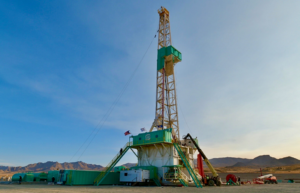 Researchers with the Frontier Observatory for Research in Geothermal Energy (FORGE) at the University of Utah have completed the first of two nearly 11,000-foot-long wells that will be used to create a geothermal reservoir where none existed naturally.
Researchers with the Frontier Observatory for Research in Geothermal Energy (FORGE) at the University of Utah have completed the first of two nearly 11,000-foot-long wells that will be used to create a geothermal reservoir where none existed naturally.
Despite the technical challenges of drilling into the abrasive hot granite, the well was completed in 84 days, nearly 40% faster than planned. Researchers collected 74 feet of valuable metamorphic and granitic core, which will be made available for study.
The Utah FORGE project is led by University of Utah civil and environmental engineering research professor Joseph Moore, chemical engineering professor John McLennan, and the U’s Energy & Geosciences Institute (EGI).
This well is part of a $220 million geothermal energy laboratory funded by the U.S. Department of Energy near Milford, Utah. The site is located within the state’s Renewable Energy Corridor, already home to two geothermal plants, a wind farm, a solar field, and a biogas facility. Thermal energy can be used to generate electricity or for direct uses such as space heating.
The second long well will be completed next year. Cold water will be injected into the newly created reservoir to extract heat from the hot rocks, pumped to the surface and then recycled back into the well.
The Utah FORGE laboratory is dedicated to developing the tools and technologies required for reservoir creation and management. Emphasis will be placed on improved drilling techniques and bit designs, isolation tools, stimulating fractures from cased wells, fracture imaging technologies, managing induced seismicity, and reservoir characterization. Once formed, these Enhanced Geothermal Systems (EGS) can provide environmentally clean, renewable and sustainable energy anywhere in the world. According to the U.S. Department of Energy, EGS has the potential to supply power to tens of millions of homes in the United States.
“Our hope”, Moore said, “is that this laboratory will serve as a prototype for similar projects around the world”.
The new well at Utah FORGE is the first time a highly deviated well optimized for EGS development has been drilled. The well was drilled vertically to 5,938 ft, deviated at a 65° angle from vertical and then continued along this trajectory for a total length of 10,987 feet. The well ultimately reached a vertical depth of 8,561 feet where temperatures exceed 440° Fahrenheit.
“This is a major milestone in the development of the Utah FORGE laboratory because it demonstrates, for the first time, long-reach, highly deviated wells required for creation and management of EGS reservoirs can be drilled under very challenging conditions”, Moore said.
This research is being supported by the Utah Geological Survey, universities, national laboratories, and private companies around the world. Utah FORGE is also collaborating closely with faculty members and students from the University of Utah’s College of Engineering, College of Mines and Earth Sciences, College of Education, and College of Humanities.
You can follow Utah FORGE activities on the website, Twitter, Facebook or LinkedIn.